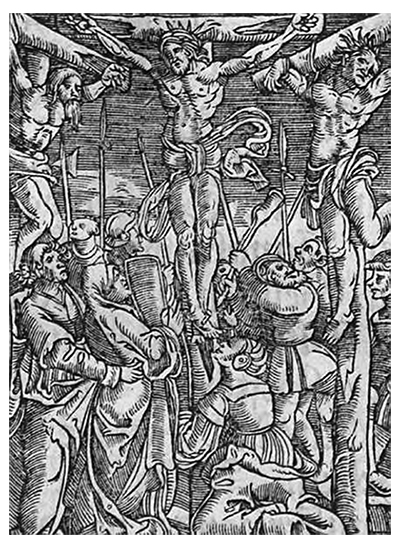Back to the Catechism: The Creed
This article reflects on the section of Luther’s Small Catechism dealing with the Creed. Read the relevant portion online in contemporary English here.
We All Believe in One True God
by Edward G. Kettner

The crucifixion of Christ . Woodcut from the 1558 edition of Luther’s Small Catechism.
When Luther outlined the order of the catechism, he noted that first we need to see what God would have us do and leave undone. Then we need to see what provision God has made for us because we have not done or have left undone what God says we should. The commandments clearly give us instruction for our life as we should live it as people of God, and show us that we have not lived up to their standards. From there Luther takes us to the Creed, where we see what God has done to preserve our lives, both on earth and in relationship to Him.
While there are three creeds that have been widely used in the Church down through the ages, the focus in the Catechism is on the Apostles’ Creed. This Creed has become the creed used in baptism, the creed which summarizes what the Scriptures teach about the God Who Is, and the God whom we confess as our saving God.
Luther was the first to organize the Creed into three articles. This Trinitarian emphasis sets forth God’s three main works on our behalf: creation, redemption, and sanctification. All three persons of the Trinity are involved in all divine works, yet in each of these works one or another member of the Trinity takes centre stage, as it were. And as Luther explains the Creed, he brings out the personal side of faith, as he has us testify that this is all done “for me.”
Thus, the first article of the Creed focuses on God the Father, and on the work of creation. God as Father refers first and foremost to His place within the Godhead, yet we are also told that God gives us the blessings of this earthly life out of “fatherly divine goodness and mercy,” showing that God has a fatherly relationship to all of creation. Luther reminds us that because God has given us all the blessings of this earthly life without any merit or worthiness in us, it is our duty to “thank, praise, serve, and obey Him.” This article call us back to the commandments, reminding us of their importance, but at the same time reminding us how far we fall short in our thanks, praise, service, and obedience.
The second article highlights the centerpiece of our faith, the person and work of Christ “for me.” Jesus is “my Lord,” because he has “redeemed me.” The law shows me to be a “lost and condemned sinner,” but Christ has redeemed me with His “holy, precious blood” and His “innocent suffering and death,” to make me His own. So Jesus’ Lordship comes about because He has redeemed me. We don’t choose to make Him our Lord; He has made Himself our Lord. In so doing we receive life in “everlasting righteousness, innocence, and blessedness.”
The third article points out that the Holy Spirit brings the blessings of Christ to me and transforms me through the Gospel as He calls, gathers, enlightens, and sanctifies me, making me a member of the Church, forgiving me my sins, and on the Last Day raising me from the dead and giving me eternal life along with all believers in Christ. Note how Luther takes us through each statement of this article and weaves it together, showing the fullness of God’s work for us.
In all these articles, Luther leads each of us who has been created, redeemed, and sanctified by the Triune God, to boldly and loudly confess, “This is most certainly true!” This is a declaration of our trust in this God and in His promises to us. It is in fact the meaning of that word “Amen!”
The creeds of the church were developed and honed over the first centuries after Christ’s ascension, as the Church saw how important it is to succinctly declare the faith to itself and to the world. The Church has confessed the creeds as we have them for nearly a millennium and a half, putting God’s words into our mouths to reinforce the faith in our hearts.
The Church has confessed the creeds as we have them for nearly a millennium and a half, putting God’s words into our mouths to reinforce the faith in our hearts.
Yet from time to time some have tried to reinvent the creeds to bring the church “up to date,” to make it more “relevant” or to try something new in the name of “creativity.” These attempts always fall short, whether by putting the focus on the individual and his/her believing rather than on the work that God has done “for me”; or by abandoning the precision of the creeds in favor of expressing faith in some amorphous deity that has done something for us but which is never explicitly stated.
By God’s grace, the Christian faith has been preserved and confessed by the Church with these creeds, and, through this, God has preserved His Church. Why would we want or need anything else than this?
———————
Rev. Dr. Edward G. Kettner is Professor Emeritus of Systematic Theology at Concordia Lutheran Seminary (Edmonton).
This article is the second in a series exploring the six chief parts of Luther’s Small Catechism. See them all (as they are published) here.





